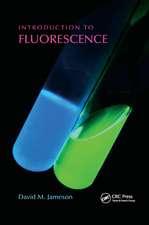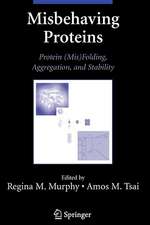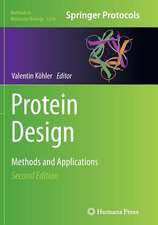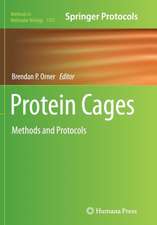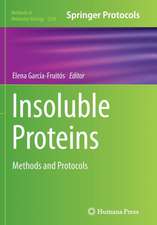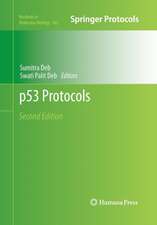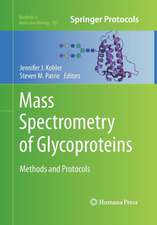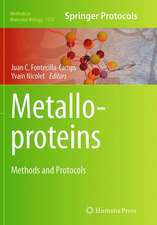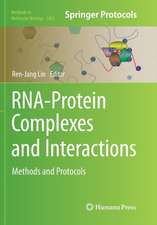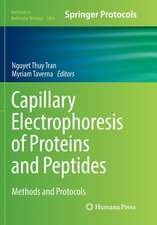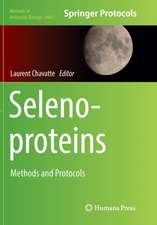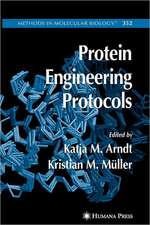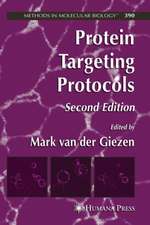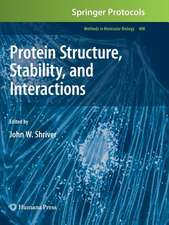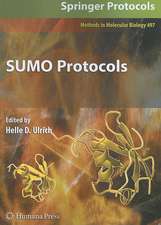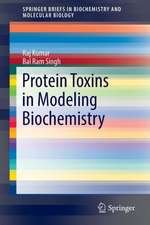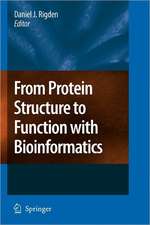Chemistry of Protein and Nucleic Acid Cross-Linking and Conjugation
Autor Shan S. Wong, David M. Jamesonen Limba Engleză Hardback – 10 oct 2011
Updated to reflect the advances of the 21st century, this book offers:
- An overview of the chemical principles underlying the processes of cross-linking and conjugation
- A thorough list of cross-linking reagents published in the literature since the first edition, covering monofunctional, homobifunctional, heterobifunctional, multifunctional, and zero-length cross-linkers
- Reviews of the use of these reagents in studying protein tertiary structures, geometric arrangements of subunits within complex proteins and nucleic acids, near-neighbor analysis, protein-to-protein or ligand–receptor interactions, and conformational changes of biomolecules
- Discusses the application of immunoconjugation for immunoassays, immunotoxins for targeted therapy, microarray technology for analysis of various biomolecules, and solid state chemistry for immobilizations
| Toate formatele și edițiile | Preț | Express |
|---|---|---|
| Paperback (1) | 327.01 lei 43-57 zile | |
| CRC Press – 14 oct 2024 | 327.01 lei 43-57 zile | |
| Hardback (1) | 1955.07 lei 43-57 zile | |
| CRC Press – 10 oct 2011 | 1955.07 lei 43-57 zile |
Preț: 1955.07 lei
Preț vechi: 2384.24 lei
-18% Nou
Puncte Express: 2933
Preț estimativ în valută:
374.09€ • 391.64$ • 309.54£
374.09€ • 391.64$ • 309.54£
Carte tipărită la comandă
Livrare economică 07-21 aprilie
Preluare comenzi: 021 569.72.76
Specificații
ISBN-13: 9780849374913
ISBN-10: 084937491X
Pagini: 622
Ilustrații: 198 b/w images, 3 color images, 27 tables and approx 2 equations
Dimensiuni: 178 x 254 x 33 mm
Greutate: 1.29 kg
Ediția:Revizuită
Editura: CRC Press
Colecția CRC Press
Locul publicării:Boca Raton, United States
ISBN-10: 084937491X
Pagini: 622
Ilustrații: 198 b/w images, 3 color images, 27 tables and approx 2 equations
Dimensiuni: 178 x 254 x 33 mm
Greutate: 1.29 kg
Ediția:Revizuită
Editura: CRC Press
Colecția CRC Press
Locul publicării:Boca Raton, United States
Public țintă
Academic and ProfessionalCuprins
Overview of Protein Conjugation. Review of Protein and Nucleic Acid Chemistry. Reagents Targeted to Specific Functional Groups. How to Design and Choose Cross-Linking Reagents. Homobifunctional Cross-Linking Reagents. Heterobifunctional Cross-Linkers. Multifunctional Cross-Linking Reagents. Monofunctional and Zero -Length Cross -Linking Reagents. General Approaches for Chemical Cross-Linking. Analysis of Cross-Linked Products. Applications of Chemical Cross-Linking to the Study of Biological Macromolecules. Applications of Chemical Conjugation in the Preparation of Immunoconjugates and Immunogens. Application of Chemical Conjugation for the Preparation of Immunotoxins and Other Drug Conjugates for Targeting Therapeutics. Application of Chemical Conjugation to Solid-State Chemistry. Amino Group–Directed Homobifunctional Cross-Linkers. Sulfhydryl Group– Directed Homobifunctional Cross-Linkers. Phenolate- and Imidazolyl-Group-Directed Reagents: Bisdiazonium Precursors. Group Selective Heterobifunctional Cross-Linkers. Photoactivatable Heterobifunctional Cross-Linking Reagents.
Notă biografică
Shan S. Wong, Ph.D., recently retired from the National Institutes of Health, where he served as a scientific review administrator and a program officer. In the latter capacity, he oversaw scientific programs in the area of alternative and complementary medicine. Previously, he served as director of clinical chemistry at Hermann Hospital and Lyndon B. Johnson General Hospital in Houston, Texas, and as a faculty member at the University of Texas Health Science Center at Houston. Before joining the University of Texas, Dr. Wong was a full professor of chemistry at the University of Massachusetts at Lowell. In addition to teaching at the University of Massachusetts at Lowell, he also taught chemistry courses at Denison University, Granville, Ohio, and Ohio State University, Columbus.
Dr. Wong has published extensively in various scientific journals in the area of enzymology and clinical chemistry. He has received numerous honors and awards and has been active in various professional societies.
David M. Jameson, Ph.D., joined the Department of Cell and Molecular Biology at the John A. Burns School of Medicine at the University of Hawaii in 1989, where he is presently a full professor. Before moving to Hawaii he was on the faculty of the Pharmacology Department at the University of Texas Southwestern Medical School in Dallas.
Dr. Jameson received his BS in chemistry from Ohio State University in 1971 and his PhD in biochemistry from the University of Illinois at Urbana-Champaign in 1978. His thesis advisor was Gregorio Weber, who laid the foundations of modern fluorescence spectroscopy. Dr. Jameson carried out postdoctoral research at the Université Paris-Sud at Orsay, France before returning to the University of Illinois for a postdoctoral period in Gregorio Weber’s laboratory. In 1983, he joined the Pharmacology Department at the University of Texas Southwestern Medical Center at Dallas as an assistant professor. In 1989, he moved to the University of Hawaii.
Dr. Jameson’s primary research focus has always been the development and application of fluorescence approaches for the study of biomolecular interactions, in particular protein–protein and protein–ligand interactions. He has published extensively in this area (some 130 publications to date) and has received funding from the National Science Foundation, the American Heart Association, and the National Institutes of Health. He has also received the Established Investigator Award from the American Heart Association and the 2004 Gregorio Weber Award for Excellence in Fluorescence Theory and Application. He lectures at numerous fluorescence workshops around the world and is co-organizer of the International Weber Symposium on Innovative Fluorescence Methodologies in Biochemistry and Medicine held every three years in Hawaii.
Dr. Wong has published extensively in various scientific journals in the area of enzymology and clinical chemistry. He has received numerous honors and awards and has been active in various professional societies.
David M. Jameson, Ph.D., joined the Department of Cell and Molecular Biology at the John A. Burns School of Medicine at the University of Hawaii in 1989, where he is presently a full professor. Before moving to Hawaii he was on the faculty of the Pharmacology Department at the University of Texas Southwestern Medical School in Dallas.
Dr. Jameson received his BS in chemistry from Ohio State University in 1971 and his PhD in biochemistry from the University of Illinois at Urbana-Champaign in 1978. His thesis advisor was Gregorio Weber, who laid the foundations of modern fluorescence spectroscopy. Dr. Jameson carried out postdoctoral research at the Université Paris-Sud at Orsay, France before returning to the University of Illinois for a postdoctoral period in Gregorio Weber’s laboratory. In 1983, he joined the Pharmacology Department at the University of Texas Southwestern Medical Center at Dallas as an assistant professor. In 1989, he moved to the University of Hawaii.
Dr. Jameson’s primary research focus has always been the development and application of fluorescence approaches for the study of biomolecular interactions, in particular protein–protein and protein–ligand interactions. He has published extensively in this area (some 130 publications to date) and has received funding from the National Science Foundation, the American Heart Association, and the National Institutes of Health. He has also received the Established Investigator Award from the American Heart Association and the 2004 Gregorio Weber Award for Excellence in Fluorescence Theory and Application. He lectures at numerous fluorescence workshops around the world and is co-organizer of the International Weber Symposium on Innovative Fluorescence Methodologies in Biochemistry and Medicine held every three years in Hawaii.
Descriere
An overview of the chemical principles underlying the processes of cross-linking and conjugation, this book offers a thorough list of cross-linking reagents published in the literature since the first edition, covering monofunctional, homobifunctional, heterobifunctional, multifunctional, and zero-length cross-linkers. It reviews of the use of these reagents in studying protein tertiary structures, geometric arrangements of subunits within complex proteins and nucleic acids, near-neighbor analysis, protein-to-protein or ligand–receptor interactions, and conformational changes of biomolecules. Finally, it discusses the application of immunoconjugation for immunoassays, immunotoxins for targeted therapy, microarray technology for analysis of various biomolecules, and solid state chemistry for immobilizations.

